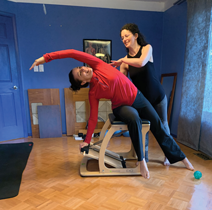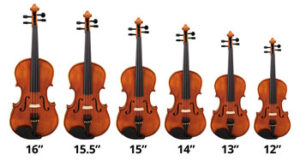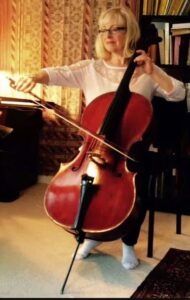In conversation with Janet Horvath
Conducted by Anika Barland

Janet Horvath, author of Playing (Less) Hurt: An Injury Prevention Guide for Musicians, Gold-Medal winner of the 2009 IPPY award, joins us for a conversation on how musicians, violists in particular, can rethink their playing habits to stay physically and mentally healthy.
String Player Issues
As the “Olympians of the small muscle groups,” musicians face the highest rate of occupational injury, with string players making up the highest percentage- 84% having at least one injury. The term for many of these injuries is RSI, repetitive stress injury. This comes from our playing and practicing habits, in combination with the effects of day-to-day living.
Horvath finds that much of the RSI problems come from static work- extending your arm out to hold your instrument or bow, tilting your head for prolonged periods, keeping a slight twist of your spine to sit on your chair, reading your music, and playing with expression. These static holds create tension and lead to fatigue. Your muscles wear and tear. You may find yourself waking up in pain or having trouble holding a pencil after a long day of practice.
Fixing it: Step 1

Lucky for us, Janet has tangible fixes we can implement throughout our day to aid in prevention and recovery. Her first fix? Simply to take breaks whenever possible, even if for a second or two. “If I could tell violists one thing, it would be to lower your arm and move it around, uncurl your fingers, lubricate your joints.”
In her book, Janet outlines a series of quick stretches musicians can do, quite discreetly, while onstage. Some quick stretches include:
- shoulder shrugs.
- shoulder rolls.
- turning your head side to side/up and down to stretch your neck.
“We are taught to appear like statues on stage, not to move. However, it is important, for our ability to play with expression, that we take small moments to release our bodies from these static holds.”
Step 2: Good Habits!
 In addition to small stretches on-stage, our off-stage habits can aid greatly in how our bodies store this tension. Stretching at home, practicing yoga or Pilates, finding a physical therapist.
In addition to small stretches on-stage, our off-stage habits can aid greatly in how our bodies store this tension. Stretching at home, practicing yoga or Pilates, finding a physical therapist.
These are all great helps. In her book, Janet provides a series of stretches you can do on a foam roller or soft surface. She even provides a series of stretches that can fit into your daily routines, “Can’t find time to stretch? Try these: they feel great in a warm shower!”
Healthy Heads
Another way to reduce our risk of injury and stay mentally healthy can be accomplished with just our thoughts. Janet warns of pre-performance anxiety, “When we are nervous, our breathing tends to be shallower. Our muscles may not get adequate blood flow and we may start to shake. Our heart rate might increase to the point that cardiac output is diminished, reducing blood flow to the brain.”
While the stresses of performing are multi-faceted and we all have our own worries, it’s known to us all that working through these negative feelings leads to a better performance and a better quality of life. Janet highlights the power of positive thinking, stating “practicing too much before you go onstage leads to overuse of your muscles. It leads to anxious thinking. Instead, visualize the music and how you would like it to sound. Tell yourself that you can play this, it is going to sound great!”
If you’re looking for something more physical, restorative stretches are great before a performance. “Try a child’s pose, do something calming.”

Violists!
For our violists, Janet has one thing on her mind, “Make certain you have a viola that plays well, one that you’re comfortable with. Size really does matter.”
The viola comes in different sizes and measurements. Consider the weight and length of the viola. When the viola is too large, you overextend your muscles trying to hold it up. Your body twists, your neck strains. “Having a well-fitted combination of shoulder and chin rests is very important. Your head should be neutral and upright. Any tilting or cocking will result in long-term damage.”

All in All:
Janet closes out our conversation with her top five rules for a healthier life as a musician.

- Warm-up. Taking the time to warm up your muscles will aid in protecting your body and preventing unnecessary strains and tears. “An athlete wouldn’t show up to their match and start playing without a proper warm-up. Why shouldn’t we do the same?”
- Take Breaks. Janet recommends a 10-minute break every hour, “Fatigued small muscles experience a 90% recovery in 10 minutes.” Set a reminder on your phone. When practicing in a large group, break whenever you can.
- Increase practice load gradually. Janet provides templates on how to gradually increase after taking a break, whether from injury, vacation, or other life circumstances.
- Vary repertoire. Give your muscles groups a break and switch out the pieces you’re working on. Janet recommends a different piece every 15 minutes.
- Reduce practice intensity before performance. Take some time to relax your mind and body. Practice some stretching or positive thinking. Your body and mind will thank you after your performance and years down the line.
Thank you to Janet Horvath for this valuable conversation. For more information, check out her book Playing (Less) Hurt: An Injury Prevention Guide for Musicians on her website: https://janethorvath.com/books/playing-less-hurt/
Additional links to Publications and Practitioners:
- International Musician, Pilates for Musicians https://internationalmusician.org/pilates-for-musicians-great-exercise-for-seated-athletes/
- Yoga for the Arts, Yoga for Musicians https://yogaforthearts.com/
- Symphonic Blog, Mental Health for Musicians https://blog.symphonic.com/2023/05/08/mental-health-resources-for-musicians/#:~:text=Over%2070%25%20of%20independent%20musicians,toll%20on%20anyone’s%20mental%20health.


